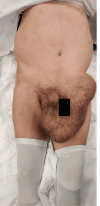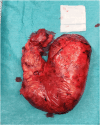The Stone Within: A Rare Case of an Incarcerated Inguinal Hernia With a Giant Fecaloma
- PMID: 40376314
- PMCID: PMC12079074
- DOI: 10.7759/cureus.82279
The Stone Within: A Rare Case of an Incarcerated Inguinal Hernia With a Giant Fecaloma
Abstract
Chronic constipation can lead to severe complications, including the formation of fecalomas, which may result in intestinal obstruction. Inguinal hernias, among the most prevalent abdominal wall hernias, can become incarcerated, leading to obstruction and ischemia. However, the occurrence of an incarcerated inguinal hernia containing a fecaloma is exceedingly rare. We present a case of a 72-year-old male who presented with a progressively enlarging left inguinal mass, urinary incontinence, and chronic diarrhea. Imaging studies revealed a significantly large left inguinoscrotal hernia containing the sigmoid colon impacted by a 4-kg fecaloma. Attempts at conservative disimpaction were unsuccessful, necessitating surgical intervention. The patient underwent a sigmoid colectomy with side-to-end colorectal anastomosis, hernia repair with prosthetic reinforcement, and a diverting ileostomy. This case highlights the importance of tailored surgical approaches in managing uncommon complications stemming from chronic constipation.
Keywords: fecaloma; incarcerated inguinal hernia; inguinal-scrotal hernia; obstipation; sigmoid colon.
Copyright © 2025, Ramalho de Almeida et al.
Conflict of interest statement
Human subjects: Consent for treatment and open access publication was obtained or waived by all participants in this study. Conflicts of interest: In compliance with the ICMJE uniform disclosure form, all authors declare the following: Payment/services info: All authors have declared that no financial support was received from any organization for the submitted work. Financial relationships: All authors have declared that they have no financial relationships at present or within the previous three years with any organizations that might have an interest in the submitted work. Other relationships: All authors have declared that there are no other relationships or activities that could appear to have influenced the submitted work.
Figures





References
-
- Fecaloma: classification, treatment, and outcomes. Souza DHS, Morais LK, Neto SG, et al. World J Colorectal Surg. 2024;13:124–130.
-
- Incarcerated inguinal hernia due to a fecaloma associated with idiopathic dolicomegacolon. De Solórzano Aurusa FJO, Carmona ZG, García CF, Obeso EG, De Andrés Asenjo B, De Heredia Rentería JB. Revista Hispanoamericana Hernia. 2018;5:73–76.
-
- Incarcerated right inguinal hernia containing sigmoid colon: a rare case report. Mahajan A, Luther A. CHRISMED J Health Res. 2014;1:281.
Publication types
LinkOut - more resources
Full Text Sources
